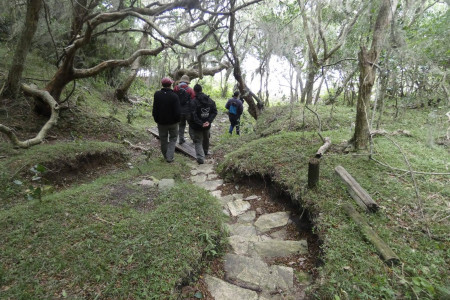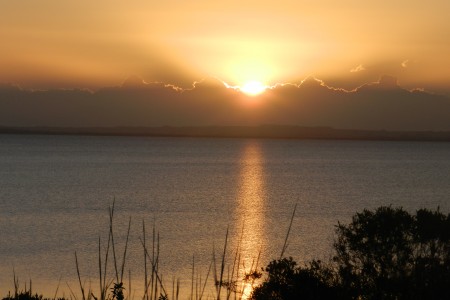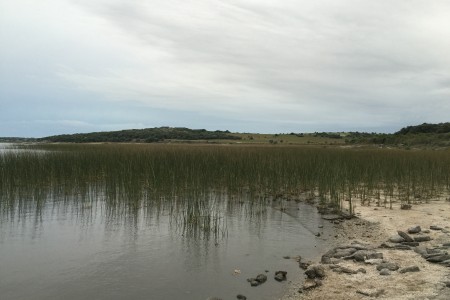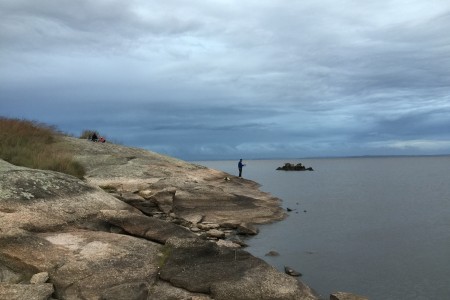A must-see
The Potrerillo de Santa Teresa Biological Station integrates, together with the Laguna Negra, one of the Protected Areas of Uruguay, managed by PROBIDES. In its 715 hectares coexist marshes, indigenous forests, meadows and sandy coasts and an important biological variety, registering more than 150 species of birds, 30 amphibians and reptiles, 27 mammals and more than 380 species of flora. It also has its archaeological value, since in one of its "cerritos de indios" the tomb of an indigenous woman buried more than 2,500 years ago with her dog was excavated in 1995.
How to get there?
El Potrerillo is located on the northeast margin of the Laguna Negra, opposite the Santa Teresa National Park entrance (route 9 km 302).
How and when can you enter?
Visitors who want to enter with their own vehicle can enter Potrerillo de Santa Teresa on Wednesdays and Saturdays. It is necessary to call PROBIDES in advance to +598 99 872 835 - +598 4472 5005 - +598 4472 8021 to coordinate the admission and visit. The tour lasts approximately 3 hours, in the company of the park rangers, through the trails conditioned for this purpose. The entrance with own vehicle has no cost.
If you do not have your own vehicle or want to enter with a specialized guide, you can contact any of the companies that appear at the end of this article.
Visitors Center
The Biological Station has a Visitor Center where a model of the site, panels with information about the natural and cultural resources of the area and its region of influence can be found, as well as an exhibition of archaeological pieces. Guided walks are offered by specially trained personnel. A bird observatory provides a comfortable and adequate place to appreciate the great diversity of species of the marshes.
Marshes
The Potrerillo lowlands and floodplains are occupied by extensive marshes that drain into the Laguna Negra, which play an important role as freshwater reserves and in the regulation of floods by acting as "sponges" retaining rainwater and water that comes from the overflow of rivers and streams.
This complex environment provides numerous shelter, feeding, nesting and breeding sites for more than 60 species of aquatic birds, both resident and migratory. The most common are herons, chajá, silver woodpecker, white faced ibis or mazaricos and diverse species of ducks. The marshes is also the home of the little bramble frog whose song, to the human ear, sounds like a "plic-plic", and of the snub-nosed frog, with a sound similar to that of the crickets.

But the most emblematic inhabitant of the Potrerillo marshes is the capybara, a robust rodent with aquatic habits, which can weigh up to 80 kilos, of which it is estimated that the population there exceeds 400 individuals.
Sandy and rocky coast

These environments, associated with the coast of the Laguna Negra, occupy less than 1% of the total surface of the Potrerillo. In them various species of our wildlife are developed.
Among the birds the pink spatulas stand out, with a pink background feathers and carmine-colored spots on the chest, shoulders and rump. White herons, storks and several species of ducks are also common. During the winter, the Potrerillo receives the visit of migratory species from more southern latitudes, such as pony-tails and double-necked, who can be seen running around the sand in search of food. In addition to the sandy beach, next to the lagoon there is a zone of ravines and rocks, crowned by native forest.
Between these ravines there are caves, hidden by the foliage, in which inhabit colonies of vampires, which feed on the blood of birds and other mammals, especially cattle. Among the rocky outcrops of the coast you may find the harmless snake of Peñarol, so called for presenting the colors of the football club of the same name (yellow and black) on its back.
Laguna Negra

The Laguna Negra (Black Lagoon) is the largest of the coastal lagoons of Uruguay, with an area of 17,500 hectares and 7 meters deep. The lands that surround it are rich in peat. In spring and summer the peat dries up, the soil cracks and the dust that the wind carries covers the surface of the waters of the lagoon, giving it a blackish color that gave rise to its name. Previously, this mirror of water received the name of Laguna de los Difuntos-Lagoon of the Deceased, taken from the hill located in its southwest corner. There, in caves located on its slopes, some indigenous skeletons and clay vessels of the Minuanes were discovered .
Indigenous forest
A small portion of the Biological Station is occupied by forests or riverine forests, which develop along the margins of the water courses. It is an environment of high landscape value, given by the diversity of species that make it up. Among the most important trees are the tarumans with aromatic flowers and strong spines and over 300 years of age. There are also ceibos, whose red flowers resemble the crest of a rooster; they are the national flower of Uruguay. The palm butiá, of delicious fruits (desired not only by the human being but also by the fox) finds in the forests of Potrerillo very favorable conditions for its regeneration. Ferns, clavel del aire (Tilandsia) and numerous vines, some of showy flowers like the mburucuyá or passiflora, complement the attraction of this environment..
The forest offers a variety of shelters - fallen trees, hollow trunks, large roots, treetops - and abundant food for many animal species. This is the habitat of the guazú-birá (the smallest of our autochthonous deer), the wildcat, the raccoon and the weasel. Among the birds are very common the juan chiviro, the blue cardinal, and two “cousins”: the sabiá and the thrush.
Meadow

The Potrerillo meadow is a very diverse plant formation: in only one square meter, 17 different species were identified, among which the grasses or "pastures" predominate. Centuries of grazing cattle and sheep were transforming the original pasture of the Potrerillo until, in 1994, the cattle were removed. This measure favored the recovery of the meadow and increased the supply of shelters and food for many species of wildlife.
Today, ferrets, skunks, apereás and ñandúes (rheas) (the largest living bird of the South American fauna) coexist in this environment, where there are also many lizards, mulitas (the smallest of our armadillos) and little owls.
During the spring, the prairie receives the visit of migratory birds like the churrinche (scarlet headed black bird), of striking fire red color and its relative, the unmistakable tijereta (scissor tail), who arrive from the North of South America to nest and raise their chicks. It is also the time of greatest activity of bees and butterflies, attracted by an endless number of delicate and aromatic flowers that dot the green tapestry of the meadow.








